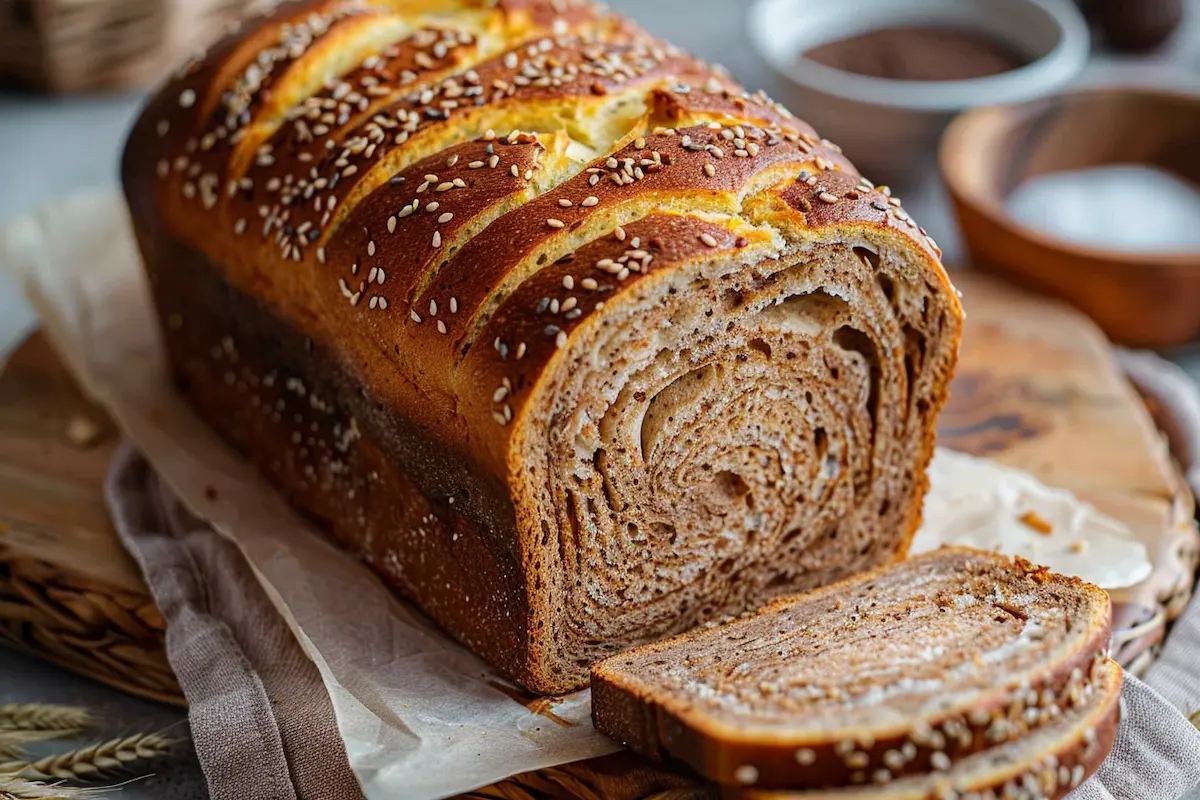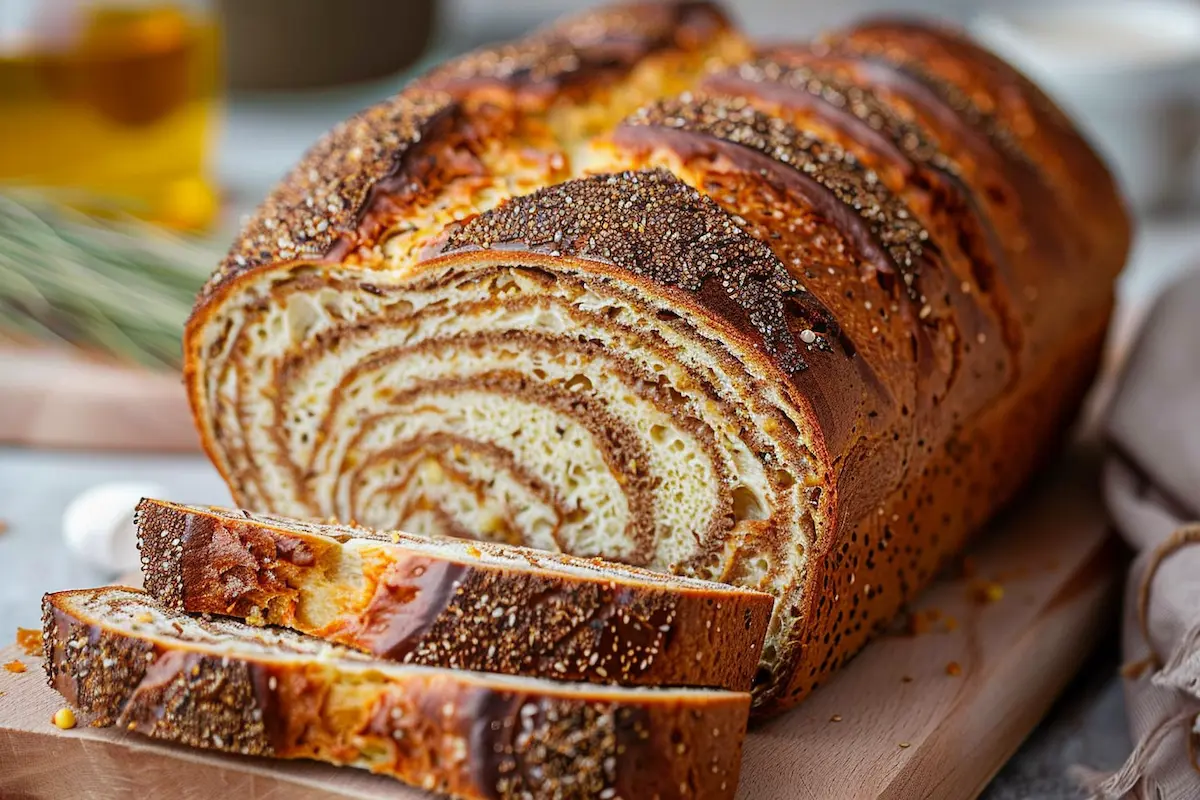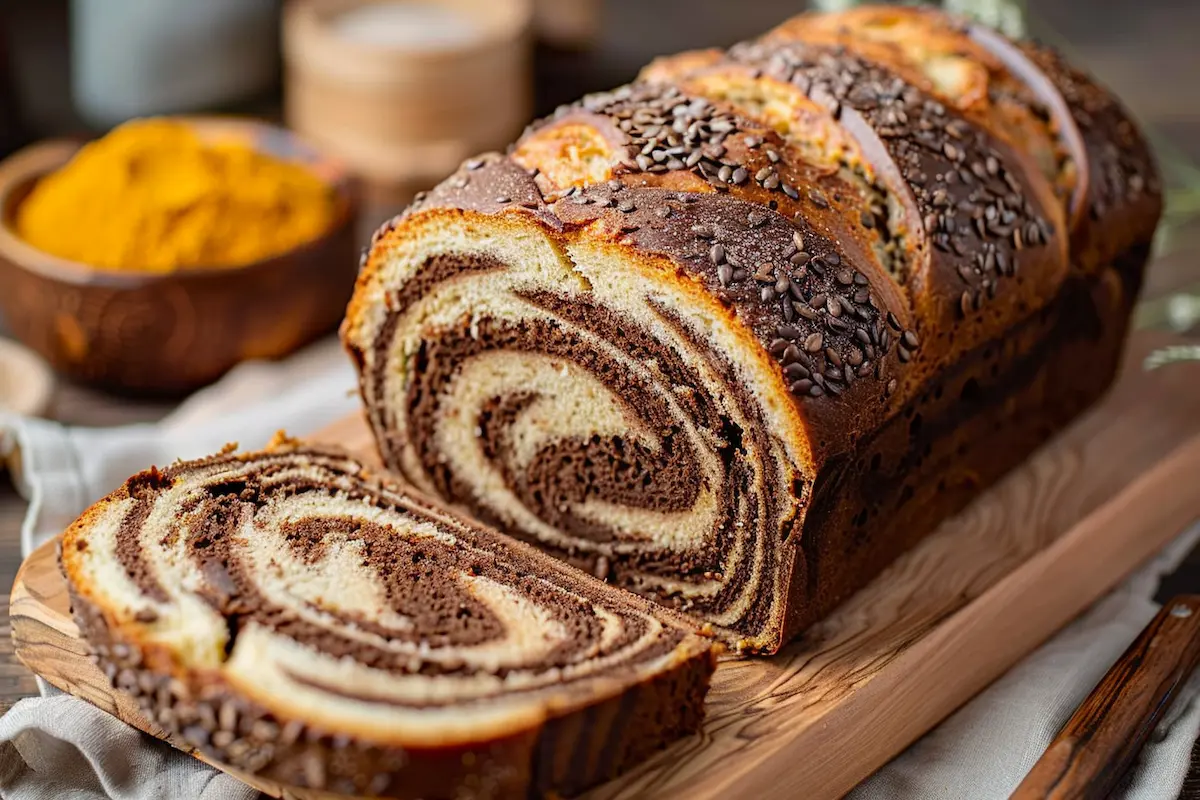Marble Rye Bread is more than just a visually appealing loaf; it’s a rich, flavorful bread that offers an irresistible combination of light and dark rye flavors. The swirling colors of this bread make it a showstopper, but it’s the unique taste that has made it a beloved classic in bakeries and homes alike.
Whether you’re preparing a gourmet sandwich, complementing a soup, or simply enjoying a slice with butter, Marble Rye Bread is versatile, nutritious, and deeply satisfying. In this comprehensive guide, we’ll take you on a journey through the history of rye bread, its ingredients, the detailed process of making Marble Rye, and plenty of creative ways to enjoy it. Along the way, we’ll provide tips, tricks, and delicious pairings that will help you master this classic loaf.
The Origins and History of Rye Bread: A Heritage of Flavor
Rye has been a staple grain for centuries, particularly in Central and Eastern Europe. Countries like Russia, Poland, and Germany are known for their rich tradition of rye bread-making, where the grain thrived in cooler climates. The cultivation of rye began as early as the Bronze Age, and it soon became a popular choice for bread due to its resilience in harsh growing conditions. Rye bread was often the go-to food for peasants and working-class families because it was affordable and filling.
Over time, the humble rye loaf began to evolve. Bakers began experimenting with different recipes, blending rye with wheat and other flours to create lighter, softer textures. Marble Rye Bread is a testament to that evolution. The swirled design combines light rye and dark rye doughs, offering not only a striking appearance but also a blend of mild and robust flavors.
In Jewish delis across New York, Marble Rye became a quintessential choice for iconic sandwiches such as pastrami and corned beef. It soon gained popularity across America, cementing its place as one of the most beloved specialty breads available today.
For an authentic sandwich experience with this bread, you can try the Ultimate Guide to Sandwich Bread, which provides helpful tips on creating the perfect sandwich loaf.

The Unique Flavor Profile of Marble Rye Bread
Marble Rye Bread stands out not only because of its eye-catching appearance but also due to its intricate flavor profile. Rye flour, known for its earthy and slightly tangy taste, provides a strong backbone to the bread. The combination of molasses and cocoa powder in the dark dough layer adds depth, while the light rye dough tempers that intensity with a milder, sweeter taste.
What Makes Rye Flour Special?
Rye flour contains less gluten than wheat flour, which results in a denser, chewier texture that makes rye bread distinct. It also has a higher fiber content and is packed with essential nutrients like iron, magnesium, and phosphorus. These nutritional benefits make rye bread, including Marble Rye, a healthier option compared to traditional white bread.
Rye bread also has a lower glycemic index, which means it doesn’t spike your blood sugar as rapidly as bread made from refined flour. This makes it a popular choice for those who are looking to manage their blood sugar levels or include more whole grains in their diet. You can explore more on how to bake with different flours in our Guide to Baking Perfect Sandwich Bread.
Ingredients for Making Marble Rye Bread
To make this delicious bread, you’ll need the following ingredients. Don’t worry if you’ve never made bread before; we’ll walk you through each step!
For the Dark Rye Dough:
- 2 cups rye flour
- 1 cup bread flour
- 2 tablespoons cocoa powder
- 2 tablespoons molasses
- 1 tablespoon caraway seeds (optional)
- 1 teaspoon salt
- 1 packet (2 ¼ teaspoons) active dry yeast
- 1 cup warm water
For the Light Rye Dough:
- 2 cups bread flour
- 1 cup rye flour
- 1 tablespoon sugar
- 1 teaspoon salt
- 1 packet (2 ¼ teaspoons) active dry yeast
- 1 cup warm water
The beauty of this recipe lies in the contrast between the two doughs. The dark dough, enriched with cocoa powder and molasses, offers a bold, slightly sweet flavor, while the light dough brings a delicate balance to the mix. If you’re a fan of distinctive rye flavors, adding caraway seeds will give your bread a hint of aniseed.
For those looking for different bread-making ideas, our Mastering Danish Dough might also interest you, especially if you enjoy working with rich, flaky doughs.
Step-by-Step Guide to Making Marble Rye Bread
Step 1: Prepare the Dough
Start by preparing both the dark and light doughs. For each dough, combine the dry ingredients in separate bowls—mix the rye flour, bread flour, yeast, and salt. For the dark dough, stir in the cocoa powder and molasses, which will give it that deep, dark color and unique flavor.
Gradually add warm water to both bowls, mixing until a dough forms. Knead each dough separately for about 10 minutes until smooth and elastic. If the dough is too sticky, add a bit more flour, but be careful not to overdo it, as this can result in a tougher loaf.
Step 2: First Rise
Once your doughs are kneaded to perfection, place each one in a lightly greased bowl, cover them with a damp cloth, and leave them in a warm spot to rise for about 1 to 1 ½ hours. You’ll know the dough is ready when it has doubled in size.
If you want to make a variety of bread loaves in the future, it’s helpful to understand how dough rises and what influences its rise. For more tips on perfecting your rise times, check out our Ultimate Guide to Baking Bread.
Step 3: Shaping the Marble Rye Loaf
Now comes the fun part: creating the marbled effect! After the dough has risen, punch it down to release the air. Roll out each piece of dough into a rectangle. Stack a piece of dark dough on top of a piece of light dough, and roll them up tightly like a jelly roll. If you’d like to create a more intricate swirl, alternate between layers of light and dark dough. Once rolled, tuck the ends under and place the loaf in a greased pan.
This technique results in the beautiful marbled appearance that makes this bread so distinctive. For a detailed guide on rolling and shaping your bread, you might want to refer to our article on Marble Bundt Cake Recipes for tips on achieving a similar swirling effect in sweet baked goods.
Step 4: Final Rise and Baking
Let the dough rise again in the pan for about 45 minutes. Preheat your oven to 375°F (190°C). Once the dough has risen for the second time, bake the loaf for 30-35 minutes. You’ll know it’s done when the bread has a golden-brown crust and sounds hollow when tapped on the bottom.
Allow the bread to cool in the pan for a few minutes before transferring it to a wire rack to cool completely. This ensures that your bread stays moist and doesn’t become too dry.

Serving Suggestions: The Best Ways to Enjoy Marble Rye Bread
Marble Rye Bread is the perfect canvas for creating a variety of meals, from simple toast to gourmet sandwiches. Here are some delicious ways to enjoy your homemade loaf:
Classic Deli Sandwiches
The most iconic way to enjoy Marble Rye Bread is in a deli sandwich. Some popular choices include:
- Pastrami on Rye: Layer pastrami, mustard, and Swiss cheese between two slices of Marble Rye, and toast for a warm, melty delight.
- Reuben Sandwich: Pile corned beef, sauerkraut, Russian dressing, and Swiss cheese on Marble Rye and grill it to perfection.
- Turkey Club: For a lighter option, stack turkey, avocado, lettuce, tomato, and bacon on a couple of thick slices of bread.
If you’re looking for more ideas on creating the perfect sandwich, our Ultimate Beef Brisket Sandwich Guide offers tips on how to craft a delicious, hearty sandwich that pairs well with homemade rye bread.
Bread and Soup Pairings
Few things are as comforting as dipping freshly baked bread into a warm bowl of soup. Marble Rye Bread’s dense texture and bold flavor make it the perfect partner for soups such as:
- Tomato Basil Soup: The sweet and tangy flavors of tomato basil soup complement the earthy notes of rye.
- Cream of Mushroom: The hearty texture of Marble Rye is ideal for sopping up the creamy, savory goodness of a mushroom bisque.
- Potato Leek Soup: A slice of toasted rye adds a delicious crunch to this smooth, comforting soup.
For more ideas on how to pair bread with soups and stews, check out our Hearty Soup Recipes Guide for more suggestions.
Rye Bread and Cheese Pairings
One of the most delightful ways to enjoy Marble Rye Bread is by pairing it with cheese. The bold flavor of rye stands up well to strong, flavorful cheeses, including:
- Blue Cheese: The sharpness of blue cheese pairs beautifully with the deep, earthy flavor of dark rye.
- Brie: The creamy, mild taste of Brie is a great match for the slightly tangy rye, especially when toasted.
- Cheddar: Aged cheddar and Marble Rye make for a classic, satisfying pairing.
For those who want to delve deeper into cheese pairings, our article on Which Cheese is Best for Crackers offers a detailed look at how to match various cheeses with bread and crackers.
Sweet and Savory Toasts
Marble Rye Bread is not just for savory dishes. It can also be used to make delicious sweet and savory toasts. Here are a few ideas to try:
- Avocado Toast: Top your toasted rye bread with mashed avocado, a drizzle of olive oil, and a sprinkle of red pepper flakes for a healthy, satisfying snack.
- Honey and Ricotta: Spread creamy ricotta cheese on a slice of toasted rye and drizzle with honey for a simple, elegant treat.
- Peanut Butter and Banana: For a protein-packed breakfast, spread peanut butter on toasted rye and top with banana slices and a dash of cinnamon.
For more inspiration, visit our article on Delicious Toast Recipes for creative ideas on how to enjoy your freshly baked Marble Rye.
Health Benefits of Rye Bread: A Nutritious Choice
As mentioned earlier, rye bread offers numerous health benefits, making it a smart addition to your diet. Here’s a deeper look at what makes rye so nutritious:
High Fiber Content
Rye bread is high in dietary fiber, which promotes good digestion and helps regulate blood sugar levels. A diet rich in fiber has been linked to lower cholesterol, reduced risk of heart disease, and improved weight management.
Lower Glycemic Index
Compared to white bread, rye bread has a lower glycemic index, meaning it releases sugar more slowly into the bloodstream. This makes it a great option for people with diabetes or anyone looking to maintain stable blood sugar levels throughout the day.
Packed with Nutrients
Rye flour is a good source of essential nutrients, including magnesium, phosphorus, and iron. These minerals support various bodily functions, including bone health, energy production, and red blood cell formation.
If you’re curious about other health benefits of bread and different grains, check out our Guide to Nutritious Breads for more insight into the nutritional profiles of various bread types.
Tips and Tricks for Perfecting Your Marble Rye Bread
Even seasoned bakers can encounter challenges when baking Marble Rye Bread. Here are some common issues and how to avoid them:
Achieving the Perfect Swirl
To get that beautiful, marbled swirl, roll the doughs tightly and evenly. If the dough is too loose, the swirl may come apart during baking. Make sure the dough layers stick together by gently pressing them as you roll.
Preventing Dense Bread
Because rye flour contains less gluten than wheat flour, it can result in a dense loaf if not handled properly. Make sure to knead the dough well to develop the gluten in the bread flour, which will help give your bread a lighter texture.
For more troubleshooting tips on baking bread, our Complete Guide to Baking covers everything from dough consistency to rise times and baking techniques.

Storing, Freezing, and Reheating Marble Rye Bread
Marble Rye Bread stays fresh for several days if stored properly. Keep it in a bread box or wrapped in a clean towel at room temperature. Avoid storing it in the fridge, as refrigeration can cause the bread to dry out.
Freezing Marble Rye Bread
If you want to store your bread for a longer period, you can freeze it. Wrap the loaf tightly in plastic wrap, then place it in a freezer-safe bag. Marble Rye Bread can be frozen for up to 3 months. To thaw, let it sit at room temperature for a few hours or reheat it in the oven at 350°F for about 10 minutes.
For more tips on storing and reheating homemade bread, check out our Ultimate Guide to Bread Preservation for useful insights on how to keep your bread fresh and delicious.
Conclusion: The Joy of Baking Marble Rye Bread
Marble Rye Bread is a rewarding recipe for home bakers who want to create a stunning and delicious loaf. With its beautiful marbled appearance and rich flavor, this bread will impress both visually and taste-wise. Whether you’re making sandwiches, serving it with soups, or enjoying it with cheese, Marble Rye Bread is sure to elevate any meal.
Ready to try your hand at baking more delicious bread recipes? Explore more ideas with our Ultimate Guide to Homemade Breads and take your baking skills to the next level.

